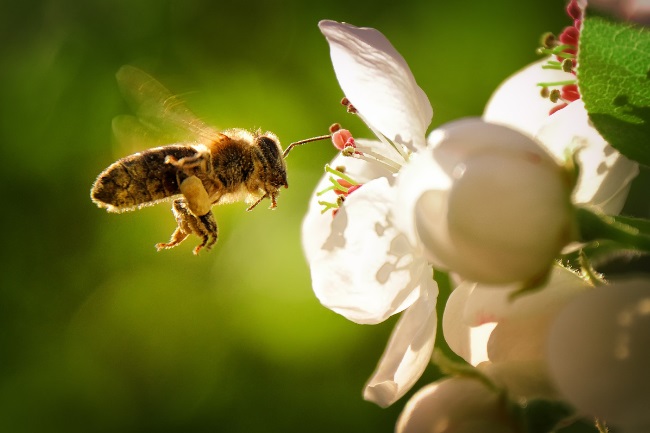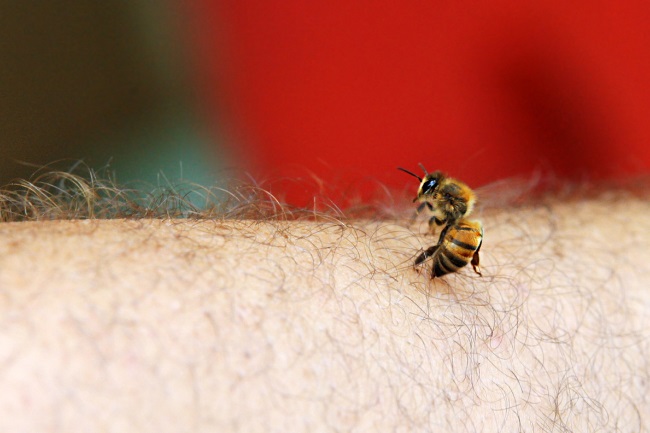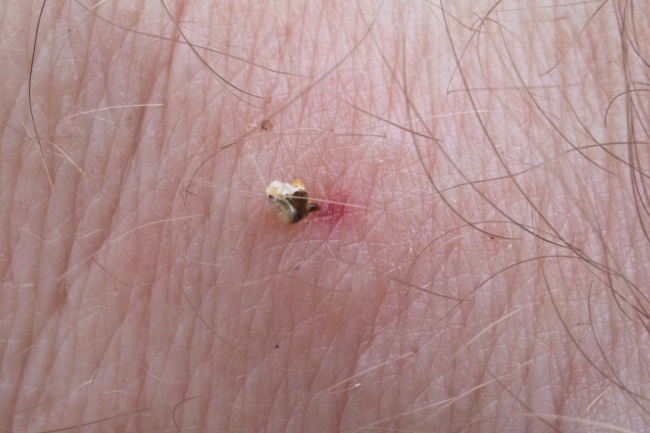Bees are incredibly valuable insects, essential pollinators and fascinating creatures. However, for many people, they are also things to be feared, primarily because of their ability to sting. Yet, most bee species do not sting humans and those that do, do it very rarely and primarily when threatened.
Contents
Do all bees sting?

Often when we talk about bees, we mean a few better-known species, and even more often, we mean the most famous one of these, the honey bee. Yet, there are around 20,000 species worldwide. They come in lots of different colours and sizes, and many of them lack the qualities we have come to associate with bees, such as living in hives, making honey, and even an ability to sting us.
Stingless bees are a group of bees that get their name from the fact they cannot sting in defence. Although they do still have stingers, these sharp and pointed body parts are much reduced. This means they are unable to use them to pierce our skin. Other groups like mining bees also have stingers too small to cause harm. Mining bees get their name from their habit of digging into the ground or sandy cliffs to make their nests. They, and many other bee species, are also much smaller than the honey bee, meaning that even if their stingers are still a proportionate size, they are still too small to do us any harm.
| Reason | Description |
|---|---|
| Defense | Bees sting as a defensive mechanism to protect themselves and their colony from perceived threats |
| Protecting the Hive | Bees may sting to defend their hive against intruders, such as predators or other insects |
| Protecting Resources | Bees may sting to protect their food sources, such as flowers or nectar-rich plants |
| Alarm Pheromones | When a bee stings, it releases alarm pheromones that signal other bees to join the defense |
Additionally, only female bees have stingers in the first place. The stinger is evolved from the female’s ovipositor, the apparatus they use for laying eggs. This means that the males do not have the right parts to produce a sting in the tail. While the majority of bees are female, queens and workers being of the fairer sex, drones are male. Males tend to do less of the work than the females in many bee societies, leaving both industry and defence to the women.
Yet, beyond all this, most bee species are simply too busy to bother stinging humans. Sweat bees, for example, are more interested in slurping up your salty perspiration than giving you a nasty shock.
Also read: Why are Bees Important to Plants? (Pollinators)
How does a bee sting?

A bee’s sting is composed of three elements, a stylet, which is the sharp pointed needle, and two lancets, barbs that slide up and down the stylet. All three are hollow and connected to a bulb at the base of the stinger. This bulb is filled with venom to feed into the stinger.
When the bee stings, it pushes the stylet into the skin, and then the hooked barbs pull it in further. The gap left where the barbs have pulled the skin apart will then allow the entrance of the venom, which travels down the hollow stylet, into the body. Most of the venom is water, which allows it to absorb even more quickly into the blood vessels.
Honey bees have an additional barb at the end of the stinger. This makes it harder to pull out. However, the majority of bees do not have this feature, and even queen honey bees have unbarbed stingers, which allow them to sting multiple times.
Also read: Can a Bumblebee Sting You? Is it Painful?
Do bee stings get worse each time?
Reactions to a bee sting can be classed as local or systemic. Local reactions are around the site of the sting and include swelling and itching. The symptoms will occur only immediately around the sting site or be spread across a larger area, such as the whole arm.
Systemic reactions are not adjacent to the sting site, such as swelling eyelids when the sting is on your leg. In general local symptoms indicate that future reactions to stings are not likely to get worse, whereas systemic reactions may be a warning sign that the next sting may cause more severe repercussions.
Only around 7% of the population are severely allergic to bee stings, and not all of these will react with an anaphylactic attack. For most people, a bee sting will never get worse than a bit of swelling or itching, but for those at risk, it is always best to play it safe and carry appropriate medication.
Will bees sting for no reason?
Most bees do not want to sting you. Stinging is a perilous pastime and could easily cost their life. For the majority of species, this weapon is the last defence. Honey bees will use their stings to defend their hives or if they feel threatened, like many species.
A few exceptions do exist, however. The Africanized ‘killer’ bees are a Frankenstein bee species, an experiment gone wrong, as beekeepers attempted to interbreed two subspecies of the honey bee to create a more productive hive. Yet the result was a species that is hard to tame and very aggressive. Now living wild, many colonies have been known to sting unfortunate individuals to death when hives are disturbed.
Also read: Is Beekeeping Cruel? Does it Harm Bees?
Does bee venom build up in your body?
Bee venom does not build up in your body over time, however, if you are stung multiple times at one time, the venom released into your body can build up to cause a toxic reaction. This can cause severe symptoms to someone who is not normally allergic to insect stings, and in some cases results in death.
Does bee sting contain poison?
Bee stingers inject venom into the creature they sting. Venom is a type of poison, a mixture of chemicals aimed at causing a negative reaction in the creature it is administered to. Most people experience a stinging or burning sensation when stung by a bee, but some people can be allergic to this venom and have much stronger reactions.
Why do bee stings cause swelling?

Bee venom is made of a cocktail of different chemicals, each geared towards making it as unpleasant a reaction as possible. Although most of the venom is composed of water, around 50% of the remaining liquid is composed of melittin. This chemical causes the red blood cells to burst and for blood vessels to expand. Other components add to this effect, such as phospholipase A2 that destroys blood cells. On top of this, your body will join in the fight, sending its histamines to the area. This chemical will cause swelling in the area, which will help isolate the toxins from the rest of the body.
Why do bee stings itch?
Bee stings itch because of the chemicals that are injected into the skin through the bee’s stinger. The stinger is a hardened appendage on the end of the abdomen that has evolved from the females ovipositor. For this reasons only female bees have a stinger.
The stinger is hollow and attached to venom sacks, which contain a number of toxic chemicals that can be mixed together for different purposes. When the bee stings its victim the sacks pump in the venom.
A number of different chemicals are present in the bee’s sting. Histamine is a key ingredient in terms of causing the itching sensation. This chemical causes swelling that becomes itchy in time
Histamines are released by your own body to fight the toxins injected by the bee’s sting. Unfortunately, they also cause an unpleasant itching. It is thought this is to attract our attention to the fact that something is wrong.
Also read: Do Ants Bite or Sting? Do They Have Teeth? (FAQ)
Do bees die after they sting?
As with many bee facts, this one relates almost entirely to the honey bee. Most bee species that do sting can sting more than once without dying, as can wasps. Honey bees have a barb on the end of their stinger, which means that it is hard to pull out once it has entered the skin. As they struggle to pull away, the bee actually pulls off part of its abdomen and dies.
However, this is just the case when stinging animals with thick skin, such as mammals. Honey bees can happily sting other insects without dying. As many of their main predators are other insects, such as wasps, this can prove very useful.
The sting in the tail
Being stung by a bee can never be said to be a pleasant experience. Yet, perhaps we have a tendency to focus too heavily on this aspect of these dynamic and valuable insects. We cannot live in a world without bees. They help pollinate our crops, our wildflowers and provide us with a wealth of knowledge about the natural world. And most of all, they do not want to sting us. They want to collect pollen, look for nesting sites, and mate. So perhaps we need to learn to enjoy and value their company a little more. After all, we need them a great deal more than they need us.

